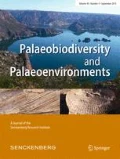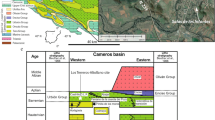Abstract
The fossil mammal fauna of the Gračanica coal mine in central Bosnia and Herzegovina includes dental remains of Anisodon (Perissodactyla, Chalicotheriidae, Chalicotheriinae). These teeth most closely resemble those of Anisodon grande from Sansan (France, MN6) and Neudorf an der March (Slovakia, MN6), and are tentatively referred to that species. Anisodon is first known in Europe from the Loire Basin (France), which has been dated as MN5. Given that the Gračanica fauna is considered to be MN5 or earliest MN6 (Langhian), the Gračanica chalicothere represents one of the earlier known finds of both the Chalicotheriinae and Anisodon in Europe. The first known members of the Chalicotheriinae are from the earliest Miocene of Asia. By the middle Miocene, Anisodon had appeared and is known from Asia and Europe, to which it had recently immigrated.



Similar content being viewed by others
References
Aiglstorfer, M., & Mayda, S. (in press). Ruminantia from the middle Miocene of the Gračanica coalmine (Bugojno, Bosnia-Herzegovina). In U.B. Göhlich & O. Mandic (Eds.), The drowning swamp of Gračanica (Bosnia-Herzegovina) - a diversity hotspot from the middle Miocene in the Bugojno Basin. Palaeobiodiversity and Palaeoenvironments 99. https://doi.org/10.1007/s12549-018-0354-z. [this issue]
Anquetin, J., Antoine, P.-O., & Tassy, P. (2007). Middle Miocene Chalicotheriinae (Mammalia, Perissodactyla) from France, with a discussion on chalicotheriine phylogeny. Zoological Journal of the Linnean Society, 151, 577–608.
Antoine, P.-O., Métais, G., Orliac, M. J., Crochet, J.-Y., Flynn, L. J., Marivaux, L., Rajpar, A. R., Roohi, G., & Welcomme, J.-L. (2013). Mammalian Neogene biostratigraphy of the Sulaiman Province, Pakistan. In X. Wang, L. J. Flynn, & M. Fortelius (Eds.), Fossil mammals of Asia: Neogene biostratigraphy and chronology (pp. 400–422). New York: Columbia University Press.
Blainville, H. M. D. de (1849). Des Anoplotheriums. In Ostéographie ou descriptions iconographique compare du squelette et du système dentaire des Mammifères récents et fossils pour server base à la zoologie et à la géologie. Atlas – Tome Quatrième: Quaternates – Maldentés: J.B. Ballière et Fils.
Bonis, L. de, Bouvrain, G., Koufos, G., & Tassy, P. (1995). Un crâne de chalicothère (Mammalia, Perissodactyla) du Miocène Supérieur de Macédoine (Grèce): remarques sur la phylogénie des Chalicotheriinae. Palaeovertebrata, 24, 135–176.
Butler, P.M. (1965). East African Miocene and Pleistocene chalicotheres. Fossil mammals of Africa no. 18. Bulletin of the British Museum (Natural History) Geology, 10,165–237.
Butzmann, R., Göhlich, U. B., Bassler, B., & Krings, M. (in press). Macroflora and charophyte gyrogonites from the middle Miocene Gračanica deposits in central Bosnia and Herzegovina. In U.B. Göhlich & O. Mandic (Eds.), The drowning swamp of Gračanica (Bosnia-Herzegovina) - a diversity hotspot from the middle Miocene in the Bugojno Basin. Palaeobiodiversity and Palaeoenvironments 99. https://doi.org/10.1007/s12549-018-0356-x. [this issue]
Chen, S.-K., Deng, T., He, W., & Chen, S.-Q. (2012). A new species of Chalicotheriinae (Perissodactyla, Mammalia) from the Late Miocene in the Linxia Basin of Gansu, China. Vertebrata PalAsiatica, 50, 53–73.
Colbert, E. H. (1935). Siwalik mammals in the American Museum of Natural History. Transactions of the American Philosophical Society, 26, 1–198.
Coombs, M. C. (1975). Sexual dimorphism in chalicotheres (Mammalia, Perissodactyla). Systematic Biology, 24, 55–62.
Coombs, M. C. (1983). Large mammalian clawed herbivores: a comparative study. Transactions of the American Philosophical Society, 73(7), 1–96.
Coombs, M. C. (2009). The chalicothere Metaschizotherium bavaricum (Perissodactyla, Chalicotheriidae, Schizotheriinae) from the Miocene (MN5) lagerstätte of Sandelzhausen (Germany): description, comparison, and paleoecological significance. Paläontologische Zeitschrift, 83, 85–129.
Coombs, M. C., & Cote, S. (2010). Chalicotheriidae. In L. Werdelin & W. J. Sanders (Eds.), Cenozoic mammals of Africa (pp. 659–667). Berkeley: University of California Press.
Costeur, L., Guérin, C., & Maridet, O. (2012). Paléoécologie et paléoenvironnement du site miocène de Sansan. Mémoires du Muséum national d'histoire naturelle, 203, 661–693.
Costeur, L., Maridet, O., Montuire, S., & Legendre, S. (2013). Evidence of northern Turolian savanna-woodland from the Dorn-Dürkheim 1 fauna (Germany). In J. L. Franzen, M. Pickford (Eds.), Dorn-Dürkheim 1, Germany: A highly diverse Turolian fauna from mid-latitude Europe.Palaeobiodiversity and Palaeoenvironments, 93(2), 259–275.
Fahlke, J. M., Coombs, M. C., & Semprebon, G. M. (2013). Anisodon sp. (Mammalia, Perissodactyla, Chalicotheriidae) from the Turolian of Dorn-Dürkheim 1 (Rheinhesssen, Germany): morphology, phylogeny, and palaeoecology of the latest chalicothere in Central Europe. In J. L. Franzen, M. Pickford (Eds.), Dorn-Dürkheim 1, Germany: A highly diverse Turolian fauna from mid-latitude Europe.Palaeobiodiversity and Palaeoenvironments, 93(2), 151–170.
Fejfar, O., Heizmann, E. P. J., & Major, P. (1997). Metaschizotherium cf. wetzleri (Kowalewsky) from the Early Miocene of Czech Republic and South Germany. In J. P. Aquilar, S. Legendre, & J. Michaux (Eds.) Actes du Congrès BiochroM’97, Mémoires et Travaux de l’École Pratique des Hautes Études, Institut de Montpellier, 21, 707–709.
Forster Cooper, C. (1922). LV – Macrotherium salinum sp. n., a new chalicothere from India. Annals and Magazine of Natural History, 10, 542–544.
Fortelius, M. (1990). Less common ungulate species from Paşalar, Middle Miocene of Anatolia (Turkey). Journal of Human Evolution, 19(4–5), 479–487.
Garevski, R., & Zapfe, H. (1983). Weitere Chalicotheriiden-Funde aus der Pikermi-Fauna von TitovVeles (Mazedonien, Jugoslawien). Acta Musei Macedonici Scientiarum Naturalium Nat., 17, 1–20.
Geraads, D., & Saraç, G. (2003). Chalicotheriidae from the Middle Miocene hominoid locality of Çandir (Turkey). In E. Güleç, D. R. Begun, & D. Geraads (Eds.), Geology and vertebrate paleontology of the Middle Miocene-hominoid locality Çandir (Central Anatolia, Turkey). Courier Forschungsinstitut Senckenberg, 240, 233–238).
Geraads, D., Spassov, N., & Kovachev, D. (2001). New Chalicotheriidae (Perissodactyla, Mammalia) from the Late Miocene of Bulgaria. Journal of Vertebrate Paleontology, 21, 596–606.
Geraads, D., Begun, D. R., & Gülec, E. (2003). The Middle Miocene hominoid site of Çandir, Turkey: general paleoecological conclusions from the mammalian fauna. In E. Güleç, D. R. Begun, & D. Geraads (Eds.) Geology and vertebrate paleontology of the Middle Miocene-hominoid locality Çandir (Central Anatolia, Turkey). Courier Forschungsinstitut Senckenberg, 240, 241–250.
Gill, T. (1872). Arrangement of the families of mammals with analytical tables. Smithsonian Miscellaneous Collections, 11, 1–98.
Ginsburg, L. (1990). The faunas and stratigraphic subdivisions of the Orleanian in the Loire Basin (France). In E. H. Lindsay, V. Fahlbusch, & P. Mein (Eds.), European Neogene mammal chronology (pp. 157–175). New York: Plenum Press.
Ginsburg, L. (2001). Les faunes de mammifères terrestres du Miocène moyen des Faluns du bassin de Savigné-sur-Lathan (France). Geodiversitas, 23(3), 381–394.
Harzhauser, M., Mandic, O., Nordsieck, H. & Neubauer, T. A. (in press). A new Helicidae (Gastropoda) from the Middle Miocene of Bosnia and Herzegovina, with a revision of the genus Paradrobacia. In U.B. Göhlich & O. Mandic (Eds.), The drowning swamp of Gračanica (Bosnia-Herzegovina) - a diversity hotspot from the middle Miocene in the Bugojno Basin. Palaeobiodiversity and Palaeoenvironments, 99. https://doi.org/10.1007/s12549-018-0344-1. [this issue]
Heissig, K. (1999). Family Chalicotheriidae. In G. Rössner & K. Heissig (Eds.), The Miocene land mammals of Europe (pp. 189–192). Munich: Verlag Dr. Friedrich Pfeil.
Heissig, K., & Fejfar, O. (2013). Die Säugetiere aus dem Untermiozän des Chomutov Beckens – I. Chalicotheriidae (Mammalia, Perissodactyla). Acta Musei Nationalis Pragae. B. – Historia Naturalis, 69, 7–64.
Kaup, J. J. (1833). Descriptions d’ossements fossils de Mammifères inconnus jusqu’à present, qui se trouvent au Muséum grand-ducal de Darmstadt (Vol. 2). Darmstadt: J.G. Heyer.
Kaup, J. J. (1859). Beiträge zur näheren Kenntniss der Urweltlichen Säugethiere. Viertes Heft. Darmstadt: Eduard Zernin.
Kaya, T. (1993). First record of Moropus elatus (Chalicotheriidae-Perissodactyla) in Turkey (Seyitömer-Kütahya). Turkish Journal of Earth Sciences, 2, 189–194.
Lartet, É. (1837). In H. M. D de Blainville (Ed.), Rapport sur un nouvel envoi de fossiles provenant du dépôt de Sansan. Comptes Rendus de l’Académie desSciences, 5, 417–427.
Lartet, É. (1851). Notice sur la colline de Sansan. In Extrait de l’Annuaire du Département du Gers, 1851. Auch: J.-A. Portes.
Mandic, O., Vranjkovic, A., Pavelic, D., Hrvatovic, H., De Leeuw, A. (2012). Miocene intra-montane lacustrine basins of Outer Dinarides (Croatia and Bosnia and Herzegovina). In I. Vlahovic, O. Mandic, E. Mrinjek, S. Bergant, V. Cosovic, A. De Leeuw, P. Enos, H. Hrvatovic, D. Maticec, G. Miksa, W. Nemec, D. Pavelic, V. Pencinger, I. Velic, & A. Vranjkovic (Eds.) Marine to continental depositional systems of Outer Dinarides foreland and intra-montane basins (Eocene-Miocene, Croatia and Bosnia and Herzegovina). Field Trip Guide, 29th IAS Meeting of Sedimentology, Schladming/Austria. Journal of Alpine Geology 54, 456–470.
Mandic, O., Göhlich, U. B., Krijgsman, W., De Leeuw, A., & Hrvatović, H. (2016). Lake Bugojno—three lacustrine cycles. In O. Mandic, D. Pavelić, M. Kovačić, K. Sant, N. Andrić, & H. Hrvatović (Eds.), Field trip guidebook. Lake - basin - evolution, RCMNS Interim Colloquium 2016 & Croatian Geological Society Limnogeology Workshop, 19-24 May 2016, Zagreb, Croatia (pp. 64–68). Zagreb: Croatian Geological Society.
Merceron, G., Blondel, C., Brunet, M., Sen, S., Solounias, N., Viriot, L., & Heintz, E. (2004a). The Late Miocene paleoenvironment of Afghanistan as inferred from dental microwear in artiodactyls. Palaeoecology, Palaeoclimatology, Palaeoecology, 207, 143–163.
Merceron, G., Viriot, L., & Blondel, C. (2004b). Tooth microwear pattern in roe deer (Capreolus capreolus, L.) from Chizé (Western France) and relation to food composition. Small Ruminant Research, 53, 125–138.
Onar, V., & Yildiz, B. (2005). New Chalicotheriidae (Perissodactyla-Mammalia) fossil from the Middle Miocene of Turkey (Bursa-Orhaneli). Uludağ Üniversitesi Veteriner Fakültesi Dergisi, 24, 65–68.
Owen, R. (1848). Description of teeth and portions of jaws of two extinct anthracotherioid quadrupeds (Hyopotamus vectianus and Hyop. bovinus) discovered by the Marchioness of Hastings in the Eocene deposits on the N.W. coast of the Isle of Wight; with an attempt to develop Cuvier’s idea of the classification of pachyderms by the number of their toes. Quarterly Journal of the Geological Society of London, 4, 103–141.
Petronijević, Ž. (1957). Chalicotherium grande (Lartet) in der Kohle des Pljevljabeckens (Crna Gora - Montenegro). Recueil des Travaux de l’Institut de Géologie “Jovan Žujović”, 9, 93-100 [in Serbian with German summary].
Pickford, M. (1982). Miocene Chalicotheriidae of the Potwar Plateau, Pakistan. Tertiary Research, 4, 13–29.
Qiu, Z.-X. (2002). Hesperotherium—a new genus of the last chalicotheres. Vertebrata PalAsiatica, 40, 317–325.
Qiu, Z. X., Wang, B. Y., & Xie, J. Y. (1998). Mid-Tertiary chalicothere (Perissodactyla) fossils from Lanzhou, Gansu, China. Vertebrata PalAsiatica, 36, 297–318.
Schulz, E., Fahlke, J. M., Merceron, G., & Kaiser, T. M. (2007). Feeding ecology of the Chalicotheriidae (Mammalia, Perissodactyla, Ancylopoda). Results from dental micro- and mesowear analyses. Verhandlungen Naturwissenschaftlichen Vereins Hamburg (NF), 43, 5–31.
Semprebon, G. M., Sise, P. J., & Coombs, M. C. (2011). Potential bark and fruit browsing as revealed by stereomicrowear analysis of the peculiar clawed herbivores known as chalicotheres (Perrisodactyla, Chalicotheroidea). Journal of Mammalian Evolution, 18, 33–55.
Tassy, P. (1978). Chalicotherium: le ‘cheval-gorille’. La Recherche, 9(87), 283–285.
Wessels, W., de Bruijn, H., Marković, Z., & Milivojević, M. (in press). Small mammals from the opencast lignite mine Gračanica (Bugojno, middle Miocene), Bosnia and Herzegovina. In U.B. Göhlich & O. Mandic (Eds.) The drowning swamp of Gračanica (Bosnia-Herzegovina) - a diversity hotspot from the Middle Miocene in the Bugojno Basin. Palaeobiodiversity and Palaeoenvironments 99. https://doi.org/10.1007/s12549-018-0366-8. [this issue],
Xue, X.-X., Deng, T., Coombs, M. C., & Zhang, Y.-X. (2014). New chalicothere materials from the Late Miocene of Fugu, Shaanxi, China. Vertebrata PalAsiatica, 52, 401–426.
Zapfe, H. (1979). Chalicotherium grande (Blainv.) aus der miozänen Spaltenfüllung von Neudorf an der March (Devinská Nová Ves), Tschechoslowakei. Neue Denkschriften des Naturhistorischen Museums in Wien, 2, 1–282.
Acknowledgements
Lilith-Valerie Svaricek (University Vienna) assisted in picture editing. We are grateful for helpful review comments by Denis Geraads (Muséum National d’Histoire Naturelle, Paris) and Kurt Heissig (Bayerische Staatssammlung für Paläontologie und Geologie, Munich).
Author information
Authors and Affiliations
Corresponding author
Ethics declarations
Conflict of interest
The authors declare that they have no conflict of interest.
Additional information
Publisher’s note
Springer Nature remains neutral with regard to jurisdictional claims in published maps and institutional affiliations.
This article is a contribution to the special issue "The drowning swamp of Gračanica (Bosnia-Herzegovina) - a diversity hotspot from the middle Miocene in the Bugojno Basin"
Rights and permissions
About this article
Cite this article
Coombs, M.C., Göhlich, U.B. Anisodon (Perissodactyla, Chalicotheriinae) from the middle Miocene locality Gračanica (Bugojno Basin, Gornji Vakuf, Bosnia and Herzegovina). Palaeobio Palaeoenv 100, 363–372 (2020). https://doi.org/10.1007/s12549-018-0357-9
Received:
Revised:
Accepted:
Published:
Issue Date:
DOI: https://doi.org/10.1007/s12549-018-0357-9




